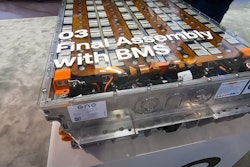Don’t blink or you may miss the latest innovation. Every day seems to bring some revolutionary new technology that promises to forever alter our world. Some of them actually will. The problem is we don’t know which ones until we all get older and can look back.
Remember 3D television? According to a report in Wired, 2010 was proclaimed, “The Year of 3D TV.” All manufacturers had ramped down production of 3D TVs just seven years later. 3D movies have a cyclical history starting in the '50s and then reemerging from “niche-dom” every few decades into the latest trend.
Battery electric cars, wind turbines and solar panels are technologies that have had similar cyclical innovation histories. These three technologies have survived decades of tidal market forces and are now rapidly achieving actual significant market penetration. Did you know that more than one-third of electric power generation capacity in the fossil fuel producing states of Texas, Oklahoma and Kansas comes from wind turbines?
A fleet manager asked me recently what the “greenness” of the grid was in New York and California. The data surprised me. Neither state’s grids are receiving energy from coal-based power plants. The two tables below are compiled from March 2023 data at the U.S. Department of Energy Information Agency’s (EIA) free Electricity Data Browser. Natural gas represents about 40% of power generation for both states. The remaining 60% is essentially distributed between “green” sources such as hydro, wind, solar and nuclear. Yes, nuclear is considered green with respect to zero greenhouse gas emissions.
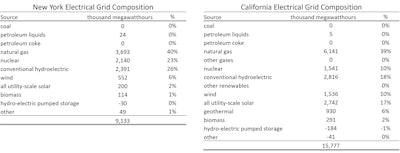
Electricity Composition in New York and California
For these two states, the arguments no longer need to be about coal. “Greenness” now shifts to talking about the complexity of issues surrounding natural gas, such as crediting renewable natural gas as a net- zero solution versus true zero-emission solution or challenges with methane leakage and its relative impact on the atmosphere.
NACFE Executive Director Mike Roeth frequently states that the North American grid gets greener every day. A variety of reports from groups like CALSTART, the Environmental Defense Fund, RMI, and many more have documented this fact. Even industry trade groups monitoring coal admit the volume of coal transported in the U.S. is steadily decreasing. The EIA’s 2021 Coal Report shows total coal production in the U.S. has fallen approximately 50% since 2003. Yet I continue to hear and read comments that electric vehicles are just a shell game with emissions.
The story for the entire U.S. is that coal is just a component of total electric energy generation as of EIA’s data from March 2023. Important still, but less so than in the past.
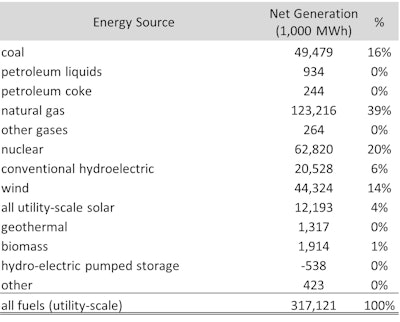
U.S. electricity composition
Lawrence Livermore National Laboratory creates an energy San Key flow diagram I see frequently on where energy originates from and where it is used. It’s a bit of an eyechart, so you should use the link and zoom in, but the left side shows the sources of all energy types consumed in the U.S. where coal is 10.5%, and almost all of that goes to electrical generation.
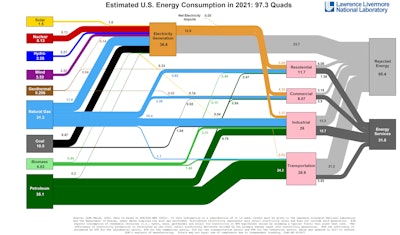
U.S. power composition
Canadian electricity generation shows fossil fuels, natural gas and coal represent less than 20% of their grid sources, according to the International Trade Administration. Mexico in 2021 produced 27% of its electrical energy from green sources, according to a DOE report. Electric trucks are here, they are real and they are taking off.
Unlike 3D television, electric vehicles are not a flash in the pan boom/bust cycle. NACFE participated recently in Schneider’s South El Monte ribbon cutting ceremony for the fleet’s new electric charging depot. This depot will have 92 Class 8 battery electric tractors operating by September, and has already put several in service delivering freight. The facility has the capability to rapidly charge 32 trucks at a time up to 350 kW levels. NACFE then visited PepsiCo’s site in Sacramento where the company has been operating a range of electric vehicles, including 18 Tesla Semis, with some approaching 100,000 miles already. Both these facilities are participating in NACFE’s Run on Less – Electric DEPOT demonstration along with six other sites.
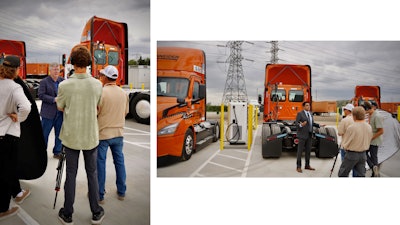
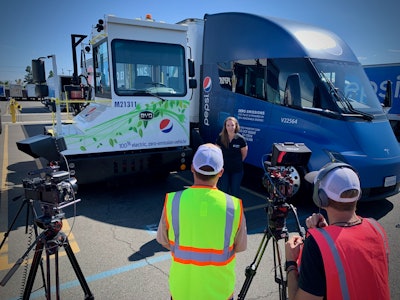
Electric vehicles are just part of the transition to zero-emission vehicles, what NACFE refers to as the messy middle, which will include a range of technologies and fuel types. All of these fuel types, to various extents, require grid electrical energy to be successful. Questions about the “greenness” of the grid supplying the path to the zero-emission future are logical to ask. There are no bad questions, only bad answers. The argument that zero-emission vehicles are somehow playing a shell game – one where the emissions occur and that, particularly, electricity from burning coal is somehow buried in the life cycle emissions – is not supported by the data.




